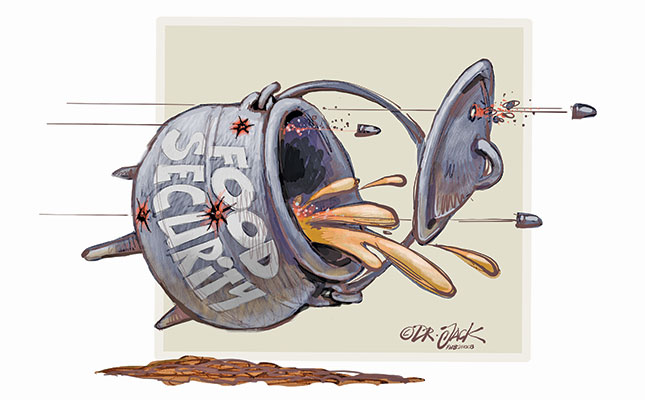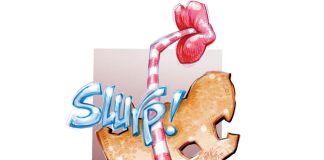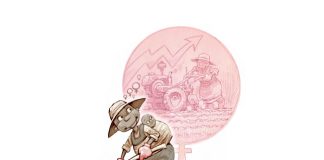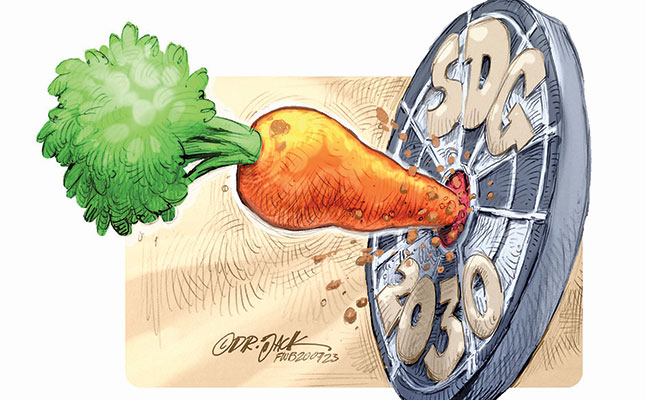
The Food and Agriculture Organization (FAO) of the United Nations and the World Food Programme (WFP) recently warned that acute food insecurity was likely to deteriorate further in 23 countries during the outlook period from August to November 2021. Ethiopia and Madagascar were the new highest-alert hotspots.
In Ethiopia, up to 401 000 people were projected to be in ‘Catastrophe’ (Phase 5 in the Integrated Food Security Phase Classification [IPC] system) between July and September 2021.
This figure, the highest number since the 2011 famine in Somalia, was due to the impact of conflict in the Tigray region. The Famine Review Committee estimated a medium to high risk of famine in three out of four possible scenarios.
In Madagascar, a total of 28 000 people will also be at risk of famine by the end of 2021, due to the country’s worst drought in 40 years.
The report emphasises the alarming rate at which acute food insecurity is rising globally. In 2020, 155 million people were estimated to be in acute food insecurity (IPC Phase 3 or above) across 55 countries/territories, up by 20 million from 2019, and this negative trend continued well into 2021.
Acute hunger is increasing not only in scale but also severity: more than 41 million people worldwide are now at risk of falling into famine or famine-like conditions unless they receive immediate life- and livelihood-saving assistance.
Conflict is expected to remain the primary driver of acute hunger, alongside economic shocks (including secondary impacts of the COVID-19 pandemic) and natural hazard risks. Higher international food prices risk further constraining vulnerable households’ access to food, as they influence domestic food prices.
The ongoing increase of climate hazards and weather extremes, and their severity, are likely to continue during the outlook period, affecting livelihoods in several parts of the world.
Democratic Republic of Congo
The Democratic Republic of Congo (DRC) remains the country with the highest number of food-insecure people globally, with approximately 27,3 million experiencing high levels of acute food insecurity between February and July 2021.
This is a result of numerous consecutive shocks, including protracted violence, natural disasters, epidemics, refugee inflows, economic decline and the impact of COVID-19. While a slight improvement is projected for the period from August to December 2021, thanks to a better economic and agricultural outlook, 26,2 million people are still expected to be in crisis.
This figure includes 5,6 million people in critical food insecurity, and does not account for the effects of the Mount Nyiragongo eruption in May, and the potential conflict escalation in North Kivu and Ituri.
Mozambique
Food insecurity in northern Mozambique may deteriorate further, driven by rising violence, displacement and recurrent natural shocks. Ongoing conflict in the northern province of
Cabo Delgado, combined with rainfall deficits there and in Nampula, disrupted farming activities.
The area recovered partially during the first quarter of 2021, but agricultural output for the year is likely to be below average. As anticipated in the previous report, violence intensified in Cabo Delgado in late March when Islamist insurgents attacked the strategic town of Palma, displacing almost 70 000 people and bringing the total number of internally displaced people (IDPs) in the country to more than 732 000 by the end of April 2021.
Meanwhile, the Southern African Development Community and Rwanda announced the deployment of troops to Mozambique. Further escalation of violence in coming months would exacerbate humanitarian needs. Nationally, however, acute food insecurity is expected to improve between April and September in rural areas, as households gain access to food from their own production and as food prices stabilise.
Approximately 1,7 million people in rural and urban areas are nevertheless expected to face high levels of acute food insecurity during this period. These include 901 000 people in the three northern provinces, of whom 227 000 will face emergency conditions of hunger.
A recent IPC analysis targeting IDPs and host households in seven districts of Cabo Delgado also indicated that food insecurity would increase in the outlook period. Between April and September, an estimated 37% of IDPs and 23% of people from host households were projected to be in crisis.
In the lean season, between October 2021 and February 2022, the proportion of IDPs and people from host households in crisis is forecast to increase to 58% and 38% respectively as a result of the early depletion of cereal reserves and rising food prices.
The humanitarian response to IDPs in Cabo Delgado, Nampula, Niassa and Zambezia was scaled up, but resources were available only until August 2021. Insecurity and access constraints also continue to hamper the response, especially in conflict-affected districts.
Angola
People in Angola’s drought-stricken southern provinces of Cunene, Cuanza Sul, Cuando Cubango Benguela, Huambo, Namibe and Huila are likely to experience an extended hunger season.
Seasonal rainfall is more than 30% below the long-term average, and above-normal temperatures have led to the worst drought since 1981. Crop losses due to the drought are estimated at almost 40%.
This is the second consecutive poor agricultural season, pushing households in the south-western provinces into extreme vulnerability, increased food insecurity and livelihood losses. Admissions for severe wasting in the southern provinces continue to be higher than in the previous three years.
The current economic downturn and an outbreak of African migratory locusts have worsened the situation. (Locust outbreaks, fortunately, were largely contained by government-led control operations.)
As a result of these conditions, a consequent increase in import needs, mostly maize, is expected during the 2021/22 marketing year. The economy, which is highly dependent on oil exports, is expected to grow only marginally in 2021, following a 4% GDP contraction in 2020.
Oil export revenues are expected to remain low throughout 2021, following a decrease in exports in the first quarter of 2021. The annual inflation rate, as of May 2021, stood at 25%, driven by increasing prices of foodstuffs and a sharp currency depreciation of nearly 30% against the US dollar in 2020.
Lockdown measures reintroduced in late April, amid a second COVID- 19 wave, are likely to continue in the outlook period, putting pressure on the already eroded resources of the most vulnerable households. In January, an estimated 3,8 million people had insufficient food consumption, with 62% of households resorting to crisis or emergency coping strategies.
Given that people have been struggling to cope with these shocks, the total population in need of urgent assistance is likely to rise sharply in the coming months.
Madagascar
A severe and extended lean season is rapidly increasing food insecurity in the Grand Sud of Madagascar, where about 50% of households lost their crops to drought. The situation, the result of the worst drought in 40 years, among other factors, is likely to deteriorate sharply.
Households’ income will continue to be constrained amidst a dramatic economic downturn. Moreover, COVID-19 has caused significant job losses, while last season’s very low harvest resulted in low crop sales for farmers and low labour demand, affecting farmworkers’ livelihoods.
Fall armyworm led to maize crop losses, while a locust invasion caused considerable crop damage. The lack of pasture and water led to the death of some livestock and poor body condition in others, while an outbreak of Rift Valley fever has affected pastoralist livelihoods. Prices are likely to remain high due to lower supplies from the poor harvest.
It has been estimated that more than 1,1 million people will be at IPC Phase 3 (‘Crisis’) from April to September 2021. Of extreme concern is the most affected district of Amboasary Atsimo, with 208 770 people, or 75% of its population, in ‘Crisis’ or worse.
More than 80% of households in Amboasary Atsimo, Tsihombe and Ambovombe have experienced hunger, as they lack the resources to access food.
As households deplete their assets, a total collapse of livelihoods is highly possible. Without timely assistance at scale, there is a risk of famine occurring in some areas by the upcoming lean season.
The views expressed in our weekly opinion piece do not necessarily reflect those of Farmer’s Weekly.
This is an edited excerpt from the FAO/WFP report titled ‘Hunger hotspots: FAO-WFP early warnings on acute food insecurity’, published in August 2021.













